Create Your First Tizen Wearable Native Watch Application
Welcome to Tizen Wearable Native watch application development!
A wearable native watch application is created using the C language, and can be run on Tizen Wearable devices to display a customized watch face to the user.
Study the following instructions to help familiarize yourself with the Tizen Native application development process as well as using Tizen Studio and installing the created application on the emulator or target device. With the instructions, you can create and run a basic wearable native watch application, which displays some text and the current time on the screen:
-
Before you get started with developing Tizen applications, download and install the Tizen Studio.
For more information on the installation process, see the installation guide.
-
Create a wearable native watch project using Tizen Studio.
This step shows how you can use a predesigned project template that creates all the basic files and folders required for your project.
-
After you have implemented code for the features you want, this step shows how you can build the application to validate and compile the code.
-
This step shows how you can run the application on the emulator or a real target device.
-
This step shows how you can create the application UI and make small alterations to it to improve the usability of your application.
When you are developing a more complex application, you can take advantage of the native tools included in Tizen Studio to ease the tasks of creating functionality and designing the application UI.
Creating a Project
The following example shows you how to create and configure a basic wearable native watch application project in Tizen Studio. An application project contains all the files that make up an application.
The following figure illustrates the application to be created. The application screen displays the Hello Watch text and the current time, which continues to be refreshed every second while the application runs.
Figure: Wearable native Watch application

To create the application project:
-
Launch Tizen Studio.
-
In the Tizen Studio menu, select File > New > Tizen Project.

The Project Wizard opens.
-
In the Project Wizard, define the project details.
The Project Wizard is used to create the basic application skeleton with the required folder structure and mandatory files. You can easily create different applications by selecting an applicable template or sample for the Project Wizard to use.
-
Select the Template project type and click Next.

-
Select the profile (Wearable) and version from a drop-down list and click Next.
The version depends on the platform version you have installed and with which you are developing the application.

-
Select the Native Application application type and click Next.
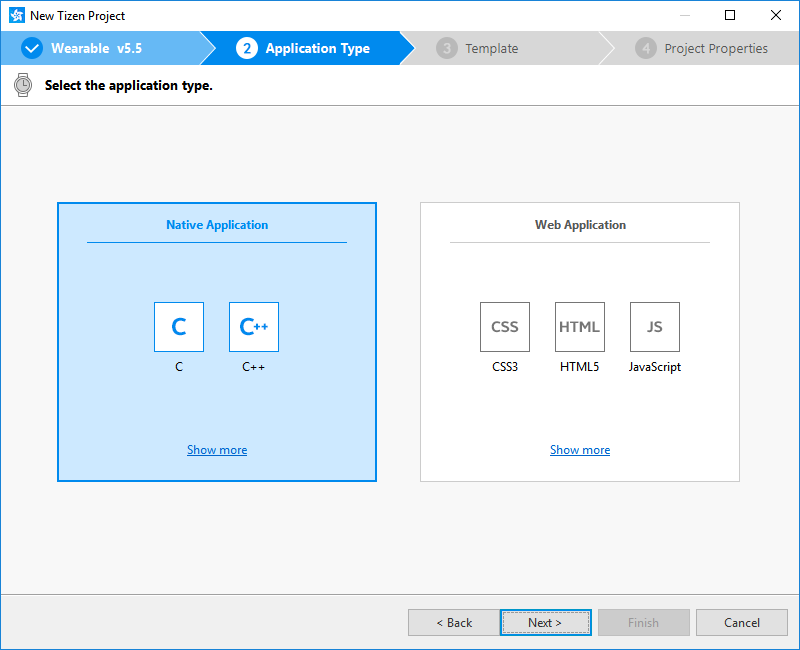
-
Select the Watch template and click Next.
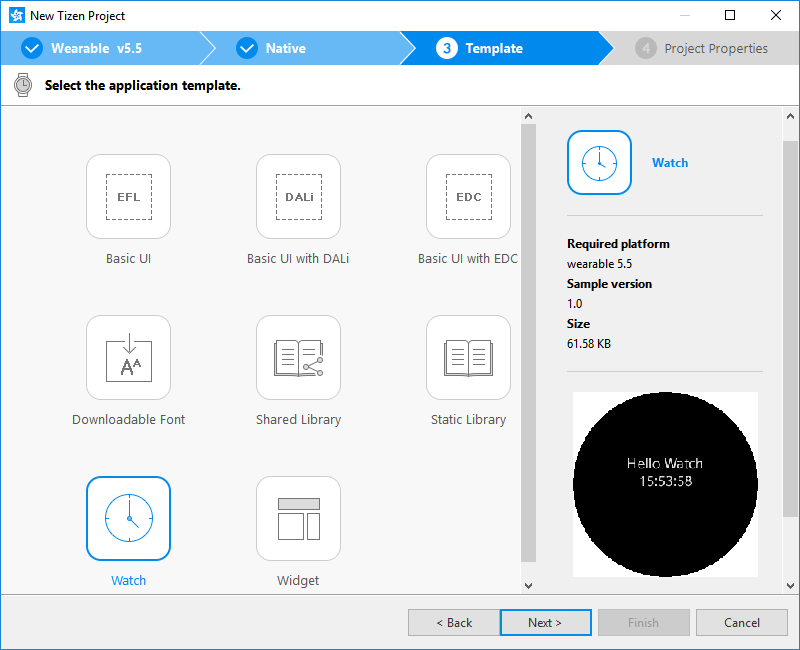
-
Define the project properties and click Finish.
You can enter the project name (3-50 characters) and the unique package ID. You can also select the location and working sets by clicking More properties.
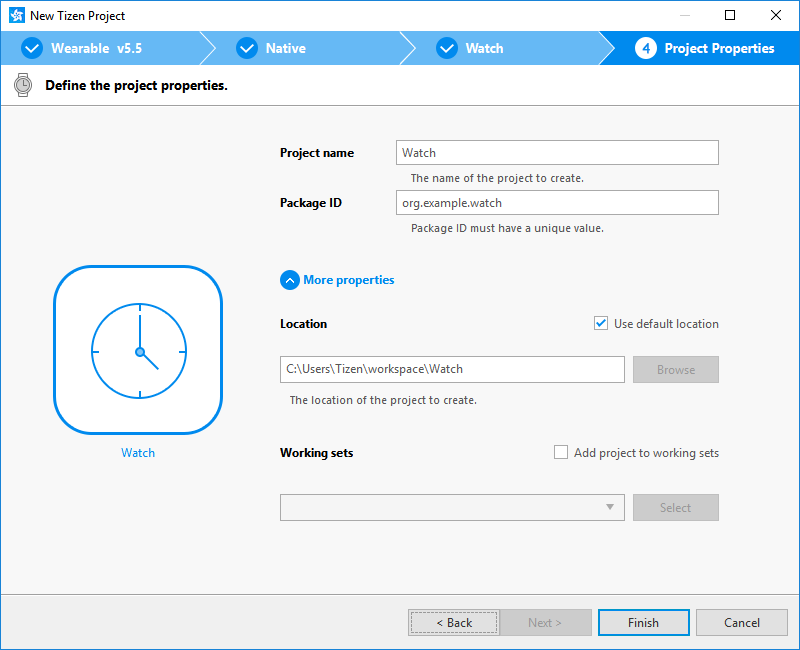
The Project Wizard sets up the project, creates the application files using the default content from the template, and closes. For more information on the Project Wizard and the available templates, see Creating Tizen Projects with Tizen Project Wizard.
-
You can see the created project in the Project Explorer view. The most important files and folders include:
-
inc: Default folder for included source files -
res: Folder for resource files used by the application only -
shared: Folder for resource files to be shared with other applications -
src: Folder for source code files -
lib: Folder for external library files -
tizen-manifest.xml: Manifest file used by the platform to install and launch the application
Figure: Application in the Project Explorer

NoteYou can view and modify the application configuration in the manifest editor. In this example, no configuration changes are required.
Your application project is now ready for further actions. Next, build the application.
Managing the Application Configuration
To view and modify the application configuration:
-
In the Project Explorer view, double-click the
tizen-manifest.xmlfile of the application. Tizen Studio opens the file in the manifest editor. -
In the manifest editor, view and modify the configuration details using the various tabs:
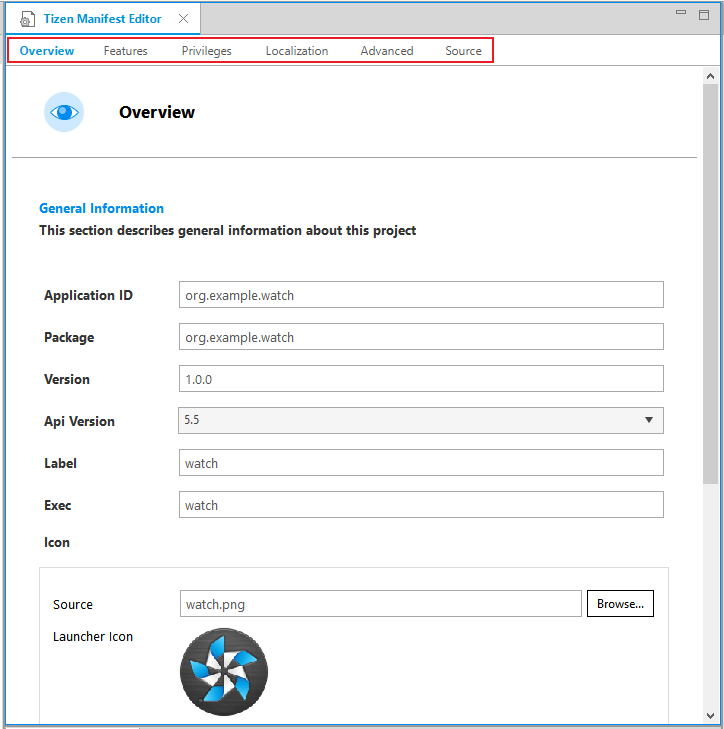
-
Overview: Define general information, such as the package, label, and icon of the application.
-
Features: Define required software and hardware features. This information is used for application filtering in the official site for Tizen applications.
-
Privileges: Define the security-sensitive APIs or API groups accessed and used by the application.
-
Localization: Define localized values for the application label, description, and icon.
-
Advanced: Define advanced features, such as application metadata and some miscellaneous options.
-
Source: View and edit the source code of the
tizen-manifest.xmlfile. Changes made and saved on the other tabs are reflected in the source code and vice versa.Note
The
tizen-manifest.xmlfile must conform to both the XML file format and the Tizen Native application specification requirements. Editing the file in the Source tab is intended for advanced users only.
-
-
To save any changes, in the Tizen Studio menu, select File > Save All.
For more information on configuring the application, see Setting the Application Manifest.
Understanding the Source Code
Pay attention to the following main issues in the application source code (in the inc/watch.h and src/watch.c files), to understand how the application is designed and how it works. For source code details related to the UI, see Designing a Simple UI.
-
The watch application is initialized to use the functions and data types of the Watch Application API by including the
<watch_app.h>header file in your application:#include <watch_app.h>All header files that you need are already included in the
watch.hfile, which is generated by Tizen Studio when the template project is created. -
The life-cycle callbacks manage specific parts of the application life-cycle. They are set in the watch_app_lifecycle_callback_s structure, and the structure is passed to the
watch_app_main()function of the Watch Application API to start the watch application event loop:int main(int argc, char *argv[]) { appdata_s ad = {0,}; int ret = 0; watch_app_lifecycle_callback_s event_callback = {0,}; app_event_handler_h handlers[5] = {NULL,}; event_callback.create = app_create; event_callback.terminate = app_terminate; event_callback.pause = app_pause; event_callback.resume = app_resume; event_callback.app_control = app_control; event_callback.time_tick = app_time_tick; event_callback.ambient_tick = app_ambient_tick; event_callback.ambient_changed = app_ambient_changed; ret = watch_app_main(argc, argv, &event_callback, &ad); if (ret != APP_ERROR_NONE) dlog_print(DLOG_ERROR, LOG_TAG, "watch_app_main() is failed. err = %d", ret); return ret; }-
The
createevent is triggered before the application main loop starts. In this callback, you can initialize the application resources, such as create windows and data structures.static bool app_create(int width, int height, void *data) { /* Hook to take necessary actions before the main event loop starts Initialize UI resources and application's data If this function returns true, the main loop of application starts If this function returns false, the application is terminated */ appdata_s *ad = data; create_base_gui(ad, width, height); return true; } -
The
time_tickevent is triggered at least once per second. The watch applications can get the current time from thewatch_timetime handle to draw a normal watch.static void app_time_tick(watch_time_h watch_time, void *data) { /* Called each second while your app is visible; update the watch UI */ appdata_s *ad = data; update_watch(ad, watch_time, 0); }
Note
For more information on the application life-cycle callbacks, see Applications.
-
-
An ambient mode is available on a low-powered wearable device. In this mode, the watch application shows a limited UI and receives only the ambient tick event every minute to reduce power consumption.
The details of the limited UI drawn in the ambient mode depend on the device. In addition, due to the ambient mode being a low power mode, there are limits to the colors that can be shown on the screen. Usually, when designing the ambient mode UI, draw it with limited colors (cyan, magenta, yellow, red, green, blue, black and white), and use less than 15% of the pixels on the screen. If you do not want to draw your own ambient mode UI, set the
ambient-supportattribute tofalsein the watch application manifest file to allow the platform to show a default ambient mode UI.Note
To use the ambient mode, the user must enable it in the device settings. In addition, on the Gear S2 device, the ambient mode activates only when you are wearing the watch on the wrist.
-
The
ambient_tickcallback is triggered every minute while the device is in the ambient mode. You can use the callback to update the time on your watch application in the ambient mode. In this callback, do not perform time-consuming tasks and always update the UI as quickly as possible. The platform can put the device to sleep shortly after the ambient tick expires.static void app_ambient_tick(watch_time_h watch_time, void *data) { /* Called at each minute while the device is in ambient mode. Update watch UI. */ appdata_s *ad = data; update_watch(ad, watch_time, 1); } -
The
ambient_changedcallback is triggered when the ambient mode is enabled or disabled on the device. You can use the callback to initialize your ambient mode UI.static void app_ambient_changed(bool ambient_mode, void *data) { if (ambient_mode) /* Prepare to enter the ambient mode */ else /* Prepare to exit the ambient mode */ }
-
Building Your Application
After you have created the application project, you can implement the required features. In this example, only the default features from the project template are used, and no code changes are required.
When your application code is ready, you must build the application. The building process performs a validation check and compiles your files.
You can build the application in the following ways:
-
Automatically
The automatic build means that Tizen Studio automatically rebuilds the application whenever you change a source or resource file and save the application project.
To use the automatic build:
-
Select the project in the Project Explorer view.
-
In the Tizen Studio menu, select Project > Build Automatically.
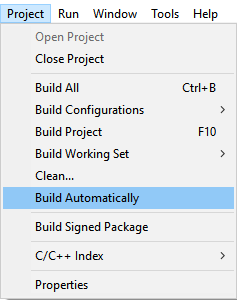
A check mark appears next to the menu option.
You can toggle the automatic build on and off by reselecting Project > Build Automatically.
-
-
Manually
The manual build means that you determine yourself when the application is built.
To manually build the application, right-click the project in the Project Explorer view and select Build Project.
Figure: Manually building the application

Alternatively, you can also select the project in the Project Explorer view and do one of the following:
- In the Tizen Studio menu, select Project > Build Project.
- Press the F10 key.
You can have more than one build configuration. To see the current active configuration or change it, right-click the project in the Project Explorer view and select Build Configurations > Set Active. The default configuration is Debug. For more information, see Building Applications.
After you have built the application, run it.
Running Your Application
You can run the application on the emulator or a real target device.
Running on the Emulator
To run the application on the emulator:
-
Launch an emulator instance in the Emulator Manager:
-
In the Tizen Studio menu, select Tools > Emulator Manager.

-
In the Emulator Manager, select a wearable emulator from the list and click Launch.
If no applicable emulator instance exists, create a new one.
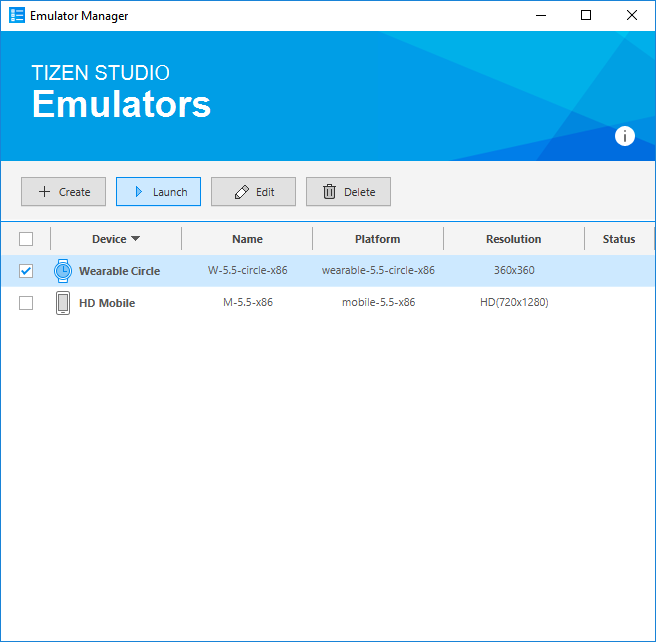
The emulator is launched in its own window. You can also see the new emulator instance and its folder structure in the Device Manager.

-
-
Generate a security profile.
Before you run the application, you must sign your application package with a certificate profile in the Tizen Studio.
-
Run the application:
-
In the Project Explorer view, right-click the project and select Run As > Tizen Native Application.
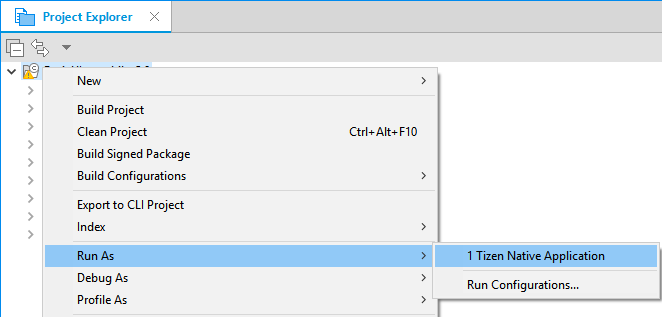
Alternatively, you can also select the project in the Project Explorer view and do one of the following:
- Press the Ctrl + F11 key.
- Click the run icon in the toolbar.
If you have created multiple emulator instances, select the instance you want from the combo box in the toolbar before selecting to run the application. If you select an offline emulator, it is automatically launched when you select to run the application.
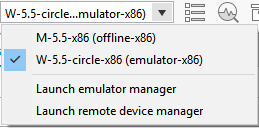
-
Confirm that the application launches on the emulator.
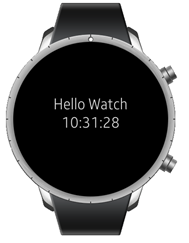
Note
If the emulator display has switched off, you cannot see the application launch. To switch the display on, click the Power key (in the lower-right corner of the emulator).
-
To change the watch face and make the installed watch application visible:

-
If the emulator display has been switched off, activate it by pressing the Power key (in the lower-right corner of the emulator).
-
On the home screen (showing the default watch face), press the Power key.
-
In the Recent Apps screen, select Settings > Watch faces and styles > Watch faces.
-
Swipe right until you find your application icon, and select it.
The Clock changed message is displayed.
-
Press the Back key (in the upper-right corner of the emulator device) multiple times, until the home screen with your new watch face is shown.

While the application is running, the Log view in Tizen Studio shows the log, debug, and exception messages from the methods defined in the log macros. To see the view, in the Tizen Studio menu, go to Window > Show View > Log.
-
-
For more information on using the emulator features, see Using Emulator Control Keys, Menu, and Panel and Using Extended Emulator Features.
Running on a Target Device
First of all, a target device and your computer must be connected to the same Wi-Fi network.
To run the application on the target device:
-
Connect the wearable target device to your computer:
-
Define settings on the device:
-
Execute the Settings application.

-
Go to Connections > Wi-Fi, and switch on Wi-Fi.

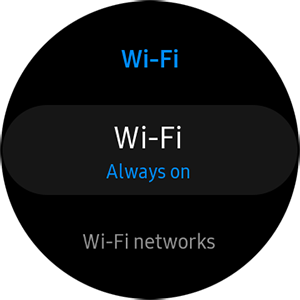
-
Go to Wi-Fi networks, and select a Wi-Fi AP.
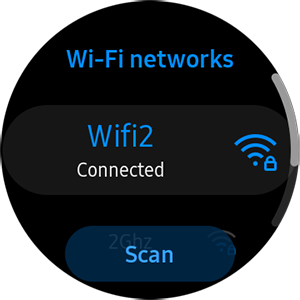
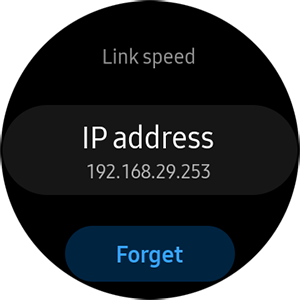
Note the IP address the device is using.
-
Go to About watch > Debugging, and switch on the debugging mode.
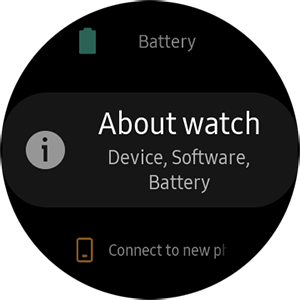
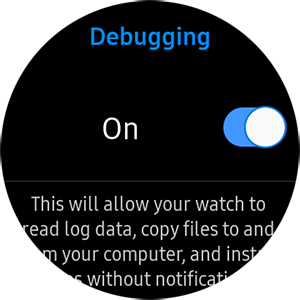
-
-
In the terminal, enter the following commands:
cd tizen-sdk/tools ./sdb connect <IP address of your device>Use the IP address you noted before.
Instead of the terminal, you can also use the Remote Device Manager for the connection.
-
In the first attempt, the connection fails and the device asks for user confirmation. To allow your device to read log data, copy files to and from your computer, and install the application manually, click the accept mark.
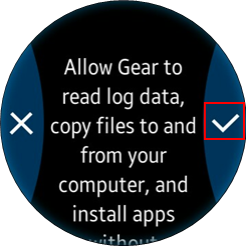
-
In the Device Manager, confirm that the device is connected.
-
-
Generate an author certificate.
Before you run the application, you must sign your application package with a certificate profile in Tizen Studio.
-
Run the application:
-
In the Device Manager, select the device.
-
In Project Explorer view, right-click the project and select Run As > Tizen Native Application.

Alternatively, you can also select the project in the Project Explorer view and do one of the following:
- Press the Ctrl + F11 key.
- Click the run icon in the toolbar.
If you have both a connected device and existing emulator instances, select the device from the combo box in the toolbar before selecting to run the application.
-
Confirm that the application launches on the target device.
Like with the emulator, you can change the watch face in the device settings to see the watch application on the home screen.
Note
The application is launched using the default debug run configuration. To create and use another configuration:
- In the
Project Explorerview, right-click the project and selectRun As > Run Configurations. - In the
Run Configurationswindow, click theNew Launch Configurationicon ( ), define the configuration details, and launch the application by clicking
), define the configuration details, and launch the application by clicking Run.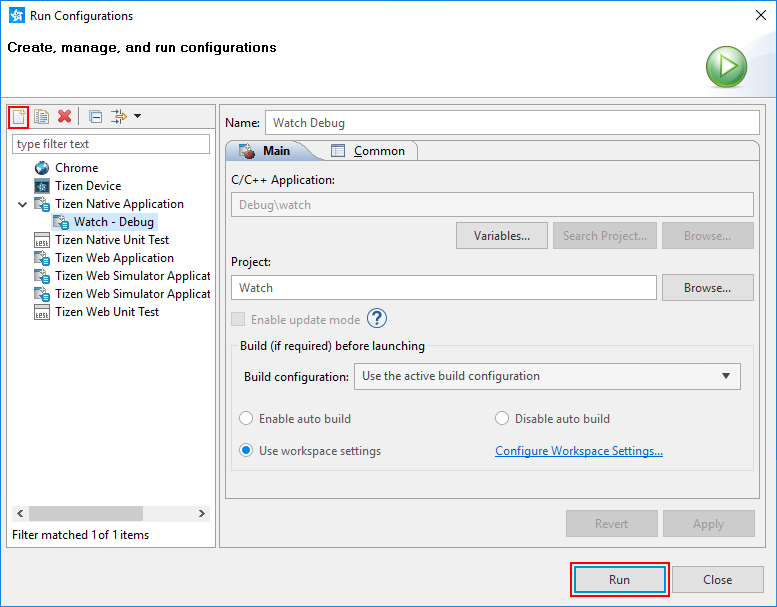
-
Designing a Simple UI
The wearable watch application created with the Watch template has a simple user interface with a label component showing the Hello Watch text and the current time (hour, minute, and second). The UI is created using EFL.
In the ambient mode, the Watch template UI is identical to the normal UI, except that is shows the current time without the seconds.
Figure: User interface in the Watch template (ambient mode on the right)
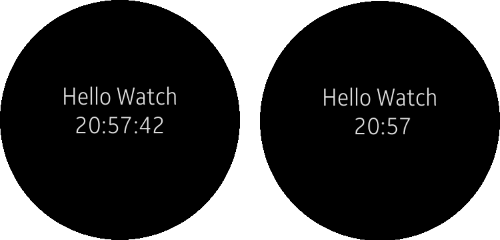
Creating the Basic UI
The UI in the Watch template contains the following components:
- The EFL UI always contains a window component, which is the root component of the entire UI.
- The application uses the conformant component as a container for other UI components.
- The label showing the Hello Watch text and the current time is implemented with a label component.
The UI is created in the watch.c file:
-
Data structure
A pointer to the UI components is stored in the
appdata_sdata structure:struct appdata { /* Window */ Evas_Object *win; /* Conformant */ Evas_Object *conform; /* Label */ Evas_Object *label; }; typedef struct appdata appdata_s; -
UI creation
The
app_create()life-cycle callback is called when the application main loop starts, and it calls thecreate_base_gui()function to create the UI:static bool app_create(int width, int height, void *data) { /* Define system callbacks */ appdata_s *ad = data; create_base_gui(ad, width, height); return true; } -
UI components
-
The
create_base_gui()function creates the UI components: window, conformant, and label.The function receives a pointer to fill in the
appdata_sstructure.static void create_base_gui(appdata_s *ad, int width, int height) { -
The window object of the idle screen is retrieved with the
watch_app_get_elm_win()function of the Watch Application API.The
watch_time_hhandle is created for managing the current time, and theevas_object_resize()function is used to resize the window to fit the screen.int ret; watch_time_h watch_time = NULL; ret = watch_app_get_elm_win(&ad->win); if (ret != APP_ERROR_NONE) { dlog_print(DLOG_ERROR, LOG_TAG, "failed to get window. err = %d", ret); return; } evas_object_resize(ad->win, width, height); -
The conformant component is used as a container for the other UI components:
- The component is the first object added inside the window with the
elm_conformant_add()function. - The conformant component is set as a resize object of the window by using the
elm_win_resize_object_add()function. It means that the conformant size and position are controlled by the window component directly. - The
evas_object_show()function makes the conformant component visible.
ad->conform = elm_conformant_add(ad->win); evas_object_size_hint_weight_set(ad->conform, EVAS_HINT_EXPAND, EVAS_HINT_EXPAND); elm_win_resize_object_add(ad->win, ad->conform); evas_object_show(ad->conform); - The component is the first object added inside the window with the
-
The label component for the text and time is added with the
elm_label_add()function. The label is added inside the conformant component, which is the label’s parent.The label is resized and moved so that it is located below the first third of the screen height.
ad->label = elm_label_add(ad->conform); evas_object_resize(ad->label, width, height / 3); evas_object_move(ad->label, 0, height / 3); evas_object_show(ad->label); -
The
watch_time_get_current_time()function retrieves the current time, and theupdate_watch()function uses the current time to set the label component content. Finally, thewatch_time_hhandle is deleted.ret = watch_time_get_current_time(&watch_time); if (ret != APP_ERROR_NONE) dlog_print(DLOG_ERROR, LOG_TAG, "failed to get current time. err = %d", ret); update_watch(ad, watch_time, 0); watch_time_delete(watch_time); -
When all the UI components are ready, the
evas_object_show()function makes the window component visible. This means that the window displays everything on the screen at once.evas_object_show(ad->win); }
-
Modifying Existing Components
When the basic UI exists, you can easily modify the components in the UI by using the component-specific functions, or more general Evas object functions.
For example, the following modification to the label component changes the text color to red:
ad->label = elm_label_add(ad->conform);
evas_object_color_set(ad->label, 255, 0, 0, 255);
evas_object_resize(ad->label, width, height / 3);
evas_object_move(ad->label, 0, height / 3);
evas_object_show(ad->label);
Figure: Modified label component
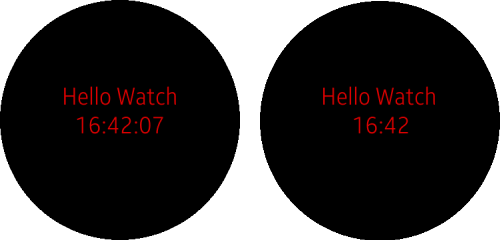
Showing the Current Time
You can update the time on the screen with the time_tick (in the normal mode) or ambient_tick (in the ambient mode) callback:
-
Both callbacks contain the current time handle, and call the
update_watch()function to update the label content on the screen:static void app_time_tick(watch_time_h watch_time, void *data) { appdata_s *ad = data; update_watch(ad, watch_time, 0); } static void app_ambient_tick(watch_time_h watch_time, void *data) { appdata_s *ad = data; update_watch(ad, watch_time, 1); } -
In the
update_watch()function, thewatch_time_hhandle is used to retrieve the current time elements (hour, minute, and second) with thewatch_time_get_hour24(),watch_time_get_minute(), andwatch_time_get_second()functions of the Watch Application API.The text for the label component is defined (based on whether the normal or ambient mode is used), and set with the
elm_object_text_set()function.static bool update_watch(appdata_s *ad, watch_time_h watch_time, int ambient) { char watch_text[TEXT_BUF_SIZE]; int hour24; int minute; int second; if (watch_time == NULL) return; watch_time_get_hour24(watch_time, &hour24); watch_time_get_minute(watch_time, &minute); watch_time_get_second(watch_time, &second); if (!ambient) { snprintf(watch_text, TEXT_BUF_SIZE, "<align=center>Hello Watch<br/>%02d:%02d:%02d</align>", hour24, minute, second); } else { snprintf(watch_text, TEXT_BUF_SIZE, "<align=center>Hello Watch<br/>%02d:%02d</align>", hour24, minute); } elm_object_text_set(ad->label, watch_text); }